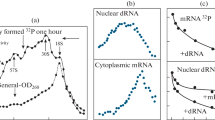Abstract
Simple repeated GATA and GACA sequences were initially identified in sex-specific snake satellite DNA. The organization of these sequences in the mouse genome is described in Schäfer et al. 1986. The expression of these simple repeats was studied here in several mouse tissues using a variety of different probes: oligonucleotides and “single-stranded” as well as nick-translated DNA. The transcription of discrete RNA species was found to be differentially regulated in several organs but sex differences in transcription were not observed. GATA- and GACA-containing cDNA clones were isolated and sequenced and a genomic clone was characterized with respect to the transcription of GATA flanking sequences. Functional aspects of GA TC A simple DNA repeats are discussed in terms of internally repetitive, hydrophobic translation products.
Similar content being viewed by others
References
Davidson EH, Britten RJ (1979) Regulation of gene expression: Possible role of repetitive sequences. Science 204:1052–1059
Epplen JT, McCarrey JR, Sutou S, Ohno S (1982) Base sequence of a cloned snake W-chromosome DNA fragment and identification of a male-specific putative mRNA in the mouse. Proc Natl Acad Sci USA 79:3798–3802
Epplen JT, Cellini A, Romero S, Ohno S (1983a) An attempt to approach the molecular mechanisms of primary sex determination: W- and Y-chromosomal conserved simple repetitive DNA sequences and their differential expression in mRNA. J Exp Zool 228:305–312
Epplen JT, Cellini A, Shorte M, Ohno S (1983b) On evolutionarily conserved simple repetitive DNA sequences: Do “sex-specific” satellite components serve any sequence dependent function. Differentiation 23 (Suppl):60–63
Epplen JT, Ohno S (1984) On structural and functional aspects of single copy and interspersed repetitive DNA. In: Sparkes RS, de la Cruz FF (eds) Research perspectives in cytogenetics. University Park Press, Baltimore pp 17–34
Epplen JT, Sutou S, McCarrey JR, Ohno S (1981) Sex-determining genes and gene regulation. In: Novy MJ, Resko JA (eds) Fetal endocrinology. Academic Press, New York pp 239–251
Epplen JT, Ohno S (1986) On DNA, RNA and sex determination. In: Lau Y-FC (ed) Selected topics in molecular endocrinology. Oxford University Press, New York, in press
Gergen JP, Stern RH, Wensink P (1979) Filter replicas and permanent collections of recombinant DNA plasmids. Nucleic Acids Res 7:2115–2136
Hu N, Messing J (1982) The making of strand-specific M13 probes and their application. Gene 17:271–277
Lewin R (1982) Repeated DNA still in search of a function. Science 217:621–623
Lewin A (1985) Genes. Wiley and Sons, New York
Maniatis T, Fritsch EF, Sambrook J (1982) Molecular cloning: A laboratory manual. Cold Spring Harbor Laboratory Cold Spring Harbor, New York
Miyada CG, Reyes AA, Studencki AB, Wallace RB (1985) Methods of oligonucleotide hybridization. Proc Natl Acad Sci USA 82:2890–2894
Norgard MV, Tocci MJ, Monahan JJ (1980) On the cloning of eukaryotic total poly (A)-RNA populations in Escherichia coli. J Biol Chem 255:7665–7672
Rigby PWJ, Dieckmann M, Rhodes C, Berg P (1977) Labeling deoxyribonucleic acid to high specific activity in vitro by nick translation with DNA polymerase I. J Mol Biol 113:237–251
Sanger F, Coulson AR, Barrell BG, Smith AJH, Roe A (1980) Cloning in a single-stranded bacteriophage as an aid to rapid DNA sequencing. J Mol Biol 143:161–178
Schäfer R, Ali S, Epplen JT (1986) The organization of the evolutionarily conserved GATA/GACA repeats in the mouse genome. Chromosoma 93:502–510
Schmidtke J, Epplen JT (1980) Sequence organization of animal nuclear DNA. Hum Genet 55:1–18
Singh L, Phillips C, Jones KW (1984) The conserved nucleotide sequences of Bkm, which define Sxr in the mouse, are transcribed. Cell 36:111–120
Singh L, Purdom IF, Jones KW (1981) Conserved sex-chromosome associated nucleotide sequences in eukaryotes. Cold Spring Harbor Symp Quant Biol 45:805–813
Skinner DM (1977) Satellite DNA's. Bioscience 27:790–796
Thomas PS (1980) Hybridization of denatured RNA and small DNA fragments transferred to nitrocellulose. Proc Natl Acad Sci USA 77:5201–5205
Tsao SGS, Brunk CF, Pearlman RE (1983) Hybridization of nucleic acids directly in agarose gels. Anal Biochem 131:365–372
Author information
Authors and Affiliations
Rights and permissions
About this article
Cite this article
Schäfer, R., Böltz, E., Becker, A. et al. The expression of the evolutionarily conserved GATA/GACA repeats in mouse tissues. Chromosoma 93, 496–501 (1986). https://doi.org/10.1007/BF00386790
Received:
Revised:
Issue Date:
DOI: https://doi.org/10.1007/BF00386790




